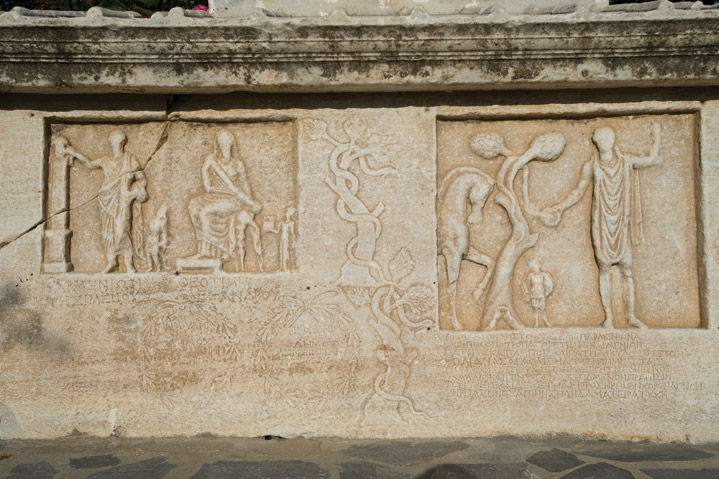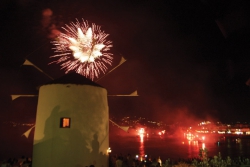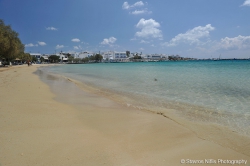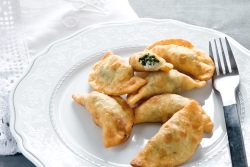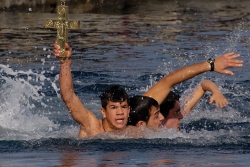Journey through Time
Keen observers can identify the rocks used thousands of years ago in the Paleolithic era by the first inhabitants of the island among the stone walls and fields. They lived in small groups, in the Cave of Demons on the Ai Yiorgi hill in Lagada and in other natural shelters. The remains of a Neolithic settlement was discovered on the islet of Saliagos (in the strait between Paros and Antiparos), which dates back to 4300-3900 BC. Its people were fishermen, hunters and farmers, who had a sense of adventure.
Small villages were built at the Kastro of Parikia, in Drios, Pyrgaki, Glyfa, Aliki (Avyssos) and near Kolybithres of Naoussa in the Cycladic era between 3200 BC and 2000 BC.
Minoan traders came to the island, which formed close ties with Crete between 2000 BC and 1500 BC, but did not leave their mark, despite the fact that Paros was called Minois or Minoa at the time. The island has also been called several other names in its long history, such as: Paktia, Dimitrias, Yria, Yliessa, Plateia and Kavarnis.
Ruins of a Myceneaean acropolis were discovered on Koukouaries hill, near Naoussa and at the castle of Parikia. The movement of tribes unsettled the Aegean region, and Paros was occupied by the Arcadians, led by Paros son of Parrasios, from whom the island took its name. The Arcadians and the newcomers from the Ionian, who arrived on the island in the world of Homer, inter-married.
The poet Archilochus the Parian was born in the 7th century BC, when Paros developed into a considerable naval force, which established colonies in Thassos, Propontida, Parion and Faron in the Adriatic Sea.
In 600 BC, Paros minted its own currency. The Hellenic religion of the Dodecatheon was practiced on the island, proof of which was found in the ruins of the temples of Eileithyia, Ypatos Dios, Aphrodite, Delion, Asclepion and Pythion Apollo on the hills surrounding Parikia. The Archaeological Museum of Paros houses exhibits from all historical eras.
The quarry in Marathi continues to extract marble. Paros is experiencing an economic and artistic boom. The Parian marble Lychnitis is in high demand and important works are produced by Parian sculptors such as Skopas and Agorakritos The main town of Paros has 50,000 residents and beautiful marble buildings including a school, theater and stadium.
In the 3rd century BC, Parian craftsmen built Delos with Parian marble, while Milos purchased marble from Paros in order to sculpt the Venus de Milo (Louvre Museum). The Parian Chronicle (Oxford, England) was drafted. And then the decline began. The Cyclades became an exile for enemies of Rome.
The Byzantine era succeeded the Roman era, and the Temple of Panagia of Ekatontapiliani, a monument of Orthodoxy, was built in Parikia, as were the Three Churches, at a distance of 1 km. from Parikia on the road to Naoussa. Christianity dominated Paros from the 3rd century AD.
The Venetian era followed, and the Sanoudos family ruled Paros for 200 years. The family was based in Parikia and built the Kastro (castle). The Kastro of Naoussa (or Kastelli, at the port of the village) was constructed in the same period, as was the castle of Kefalos (on Agios Antonios hill in Marpissa). Parian marble began traveling again, this time to Venice, and Paros flourished again.
In 1537, the island was decimated by pirate raids led by Barbarossa. The Parians continued to live in fear of the pirates. A short time later, the island was conquered by the Turks. New villages were built (Lefkes, Kostos, Marmara).
In 1774, the Russians arrived on Paros, harbored their fleet in Naoussa, on the Agia Kalis islet, and established camps, warehouses, hospitals and shipyards on the island. Paros became the center for the Russian Domination under the Orloffs. Paros played an active role in the Revolution of 1821, and the war heroine Manto Mavrogenous lived on the island. The island became part of the free Greek state. An important island culture developed.
After the end of World War II, the Parians were forced to migrate, first to Piraeus and then abroad. A new period of development began on Paros in 1970, which focused primarily on tourism.
While walking along the narrow streets of Parikia, be sure to stop in the Y. Gikas Public Library, and dive into 8,000 years of history.
Small villages were built at the Kastro of Parikia, in Drios, Pyrgaki, Glyfa, Aliki (Avyssos) and near Kolybithres of Naoussa in the Cycladic era between 3200 BC and 2000 BC.
Minoan traders came to the island, which formed close ties with Crete between 2000 BC and 1500 BC, but did not leave their mark, despite the fact that Paros was called Minois or Minoa at the time. The island has also been called several other names in its long history, such as: Paktia, Dimitrias, Yria, Yliessa, Plateia and Kavarnis.
Ruins of a Myceneaean acropolis were discovered on Koukouaries hill, near Naoussa and at the castle of Parikia. The movement of tribes unsettled the Aegean region, and Paros was occupied by the Arcadians, led by Paros son of Parrasios, from whom the island took its name. The Arcadians and the newcomers from the Ionian, who arrived on the island in the world of Homer, inter-married.
The poet Archilochus the Parian was born in the 7th century BC, when Paros developed into a considerable naval force, which established colonies in Thassos, Propontida, Parion and Faron in the Adriatic Sea.
In 600 BC, Paros minted its own currency. The Hellenic religion of the Dodecatheon was practiced on the island, proof of which was found in the ruins of the temples of Eileithyia, Ypatos Dios, Aphrodite, Delion, Asclepion and Pythion Apollo on the hills surrounding Parikia. The Archaeological Museum of Paros houses exhibits from all historical eras.
The quarry in Marathi continues to extract marble. Paros is experiencing an economic and artistic boom. The Parian marble Lychnitis is in high demand and important works are produced by Parian sculptors such as Skopas and Agorakritos The main town of Paros has 50,000 residents and beautiful marble buildings including a school, theater and stadium.
In the 3rd century BC, Parian craftsmen built Delos with Parian marble, while Milos purchased marble from Paros in order to sculpt the Venus de Milo (Louvre Museum). The Parian Chronicle (Oxford, England) was drafted. And then the decline began. The Cyclades became an exile for enemies of Rome.
The Byzantine era succeeded the Roman era, and the Temple of Panagia of Ekatontapiliani, a monument of Orthodoxy, was built in Parikia, as were the Three Churches, at a distance of 1 km. from Parikia on the road to Naoussa. Christianity dominated Paros from the 3rd century AD.
The Venetian era followed, and the Sanoudos family ruled Paros for 200 years. The family was based in Parikia and built the Kastro (castle). The Kastro of Naoussa (or Kastelli, at the port of the village) was constructed in the same period, as was the castle of Kefalos (on Agios Antonios hill in Marpissa). Parian marble began traveling again, this time to Venice, and Paros flourished again.
In 1537, the island was decimated by pirate raids led by Barbarossa. The Parians continued to live in fear of the pirates. A short time later, the island was conquered by the Turks. New villages were built (Lefkes, Kostos, Marmara).
In 1774, the Russians arrived on Paros, harbored their fleet in Naoussa, on the Agia Kalis islet, and established camps, warehouses, hospitals and shipyards on the island. Paros became the center for the Russian Domination under the Orloffs. Paros played an active role in the Revolution of 1821, and the war heroine Manto Mavrogenous lived on the island. The island became part of the free Greek state. An important island culture developed.
After the end of World War II, the Parians were forced to migrate, first to Piraeus and then abroad. A new period of development began on Paros in 1970, which focused primarily on tourism.
While walking along the narrow streets of Parikia, be sure to stop in the Y. Gikas Public Library, and dive into 8,000 years of history.









.jpg)
_1.jpg)
